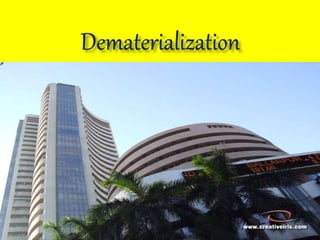
dematerialization of shares
- 2. Dematerialization is the process of converting physical shares into an electronic form. Shares once converted into dematerialized form are held in a Demat account. What Does Dematerialization-DEMAT Mean? The move efrom physical certificates to lectronic book keeping. Actual stock certificates are slowly being removed and retired from circulation in exchange for electronic recording.
- 3. New era of Indian Capital Market. How to dematerialize your shares? Fill up a dematerialization request form, which is available with your DP; Submit your share certificates along with the form; Receive credit for the dematerialized shares into your account in 15 days.
- 4. In finance and financial law, dematerialization refers to the substitution of paper-form securities by book entry securities. dematerialized securities are often referred as intermediated securities , in particular by the Unidroit convention on substantive rules for intermediated securities .
- 6. Providing the bank account details at the time of account opening. Change in bank account details. Change in the address of investor as provided to the DP. Opening multiple accounts. Minimum balance of securities required in Demat account. Account opening and ownership pattern of securities.
- 7. Same combination of names on certificates but different sequence of names on the certificates or demat account. Holding a joint account on "Either or Survivor" basis like a bank account. Allowing some body else to operate your Demat account. Addition/deletion of the names of the account holders after opening the account.
- 8. Closing a demat account and transfer of securities to another account with same or different DP. Freezing/ Locking a demat account. Dematerialized shares do not have any distinctive number.
- 10. Depository-
- 11. S. No. Basis Of Differentiation Bank Account Demat Account 1. Form of Holdings/Deposits Funds Securities 2. Used for Safe keeping of money Safekeeping of shares 3. Facilitates Transfer of money(without actually handling money) Transfer of shares (without actually handling shares) 4. Where to open A bank of choice A DP of choice (can be a bank) 5. Requirement of PAN Number Not Mandatory Mandatory (effective from April 01, 2006) 6. Interest accrual on holdings Interest income is subject to the applicable rate of interest No interest accruals on securities held in demat account 7. Minimum balance requirement AQB* maintenance is specified for certain bank accounts No such requirement 8. Either or Survivor facility Available Not available
- 12. A safe and convenient way of holding securities (equity and debt instruments both). Securities can be transferred at an instruction immediately. Pledging of securities in a short period of time. Reduced paper work and transaction cost. Odd-lot shares can also be traded (can be even 1 share). Nomination facility available.
- 14. Separate dematerialization requests will have to be filled for locked-in and free holdings. Separate dematerialization requests will have to be filled for holdings locked-in for different reasons. Separate dematerialization requests will have to be filled for fully paid up and partly paid-up holdings. Separate dematerialization requests will have to be filled for holdings in the different ISINs of a company.
- 15. Dematted shares can be converted back into physical shares. One may open accounts with several DPs. Dematerialization of shares can be canceled automatically. This takes place if a company is declared bankrupt in the so-called liquidation path .
- 16. Demat account is more or less an essential requirement for all the investors who invest in equities, bonds and debentures. . Despite various efforts by the regulators to make electronic transactions as cheap as possible for the ordinary investors, the charges for Demat accounts continue to remain on higher side. Depending upon the individual profile, requirements and suitability, different investors open DP accounts with major banks, big online broking houses or local brokers.
- 17. Getting started 1. Choose a DP 2. Fill up an account opening form provided by DP, and sign an agreement with DP in a standard format prescribed by the depository. 3. DP provides the investor with a copy of the agreement and schedule of charges for his future reference. 4. DP opens the account and provides the investor with a unique account number, also known as Beneficiary Owner Identification Number (BO ID). Documents to be attached Passport size photographs Proof of residence (POR) - Any one of Photo Ration Card with DOB / Photo Driving License with DOB / Passport copy / Electricity bill / Telephone bill Proof of identity (POI) - Any one of Passport copy / Photo Driving License with DOB / Voters ID Card / PAN Card / Photo Ration Card with DOB PAN card
- 18. A Depository NSDL is an organization like a Central Bank where at the request of a shareholder his securities are held in the electronic form through the medium of a Depository Participant. Meaning of a depository participant- A depository participant is one with whom an account has to be opened to trade in the electronic form.
- 19. The depository system operates in the lines of a banking system. A bank holds funds in its accounts and transfers funds between accounts whereas a depository holds securities in accounts and transfers securities between accounts.
- 20. Lack of control. Need for greater supervision. Complexity of the system.